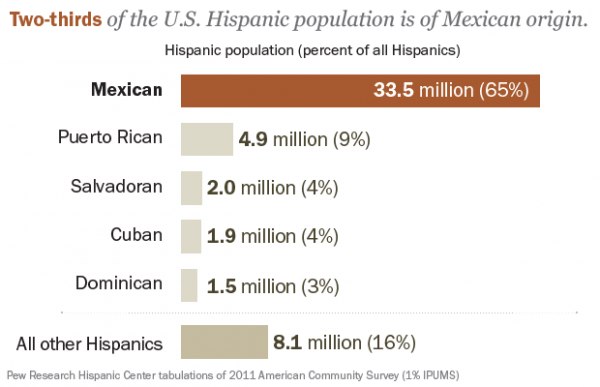
A recent data set released by the Pew Research Hispanic Center allows us to look at the dominance of the Mexican vote, the crawl to Puerto Rican statehood, and the issues that the Hispanic population present to the U.S. economy. We strongly encourage reading the linked part one and part two of this series of articles for additional context.
1.) There is no such thing as “the Latino vote.”
Yep, there is no Latino vote. It’s simply the Mexican vote as far as national politics are concerned. As we saw in part one, the Mexican-American population is a massive outlier in the data — two-thirds of the Hispanic population in the country to be exact. The 33 million-strong Mexican population towers over the other Hispanic groups, with the “all others” coming out to merely a peppering of other national groups amounting to 8.1 million.
The second largest, homogenous racial group of Hispanics only comes in with 4.9 million resident in the country: Puerto Ricans. The Mexican-American population is almost seven times larger than this.
This means that it is the Mexican-American demographic which holds the true key for votes. The other demographics are simply too small, or too regionalized, to matter when it comes to national elections.
In state elections, however, this will not hold true in every situation. Puerto Ricans, for instance, have a much stronger voting power in New York State’s elections than they do nationally.
2.) Puerto Rican statehood likely isn’t going to go very far.
Continuing off of point 1, the second-largest homogenous demographic in the Hispanic community is the Puerto Rican community. It, however, is a remarkably small demographic and very diasporic. It’s spread is very regionalized. 2010 census data shows that the Puerto Rican community is concentrated in the East Coast of the country, with one million of the 4.9 million in the state of New York. As a result, the small size of the population, as well as the regionalization, means that it is very unlikely to have much influence in pressuring the government to speed up with whatever it plans to do with the island nation. The Puerto Rican in New York population is a million people bigger than the Asian-American population, and that demographic is largely ignored.
Sadly, despite our wonderful parades and pride, we’re just too small of a demographic in national elections to really be a concern to mainstream politicos.
3.) Hispanics have lots of kids, and lots of them in single-parent households.
Nearly one quarter of the births in the country were to Hispanic women last year. Impressive. However, out of that quarter of births, 47% of them were born to unmarried women. This builds the foundation for speculation that a good number of these kids born last year have been born into poverty. An absent father means one less money earner for the household, which brings about a whole array of problems.
4.) The Hispanic community is critical to the economy.
The final point I’m making could easily be broken up into a number of articles, and certainly deserves a much more thorough analysis. However, to be succinct, the Hispanic population is crucial to the economy, but could also help bring it down. The Hispanic population is growing, however, income of this population is low: households with single mothers don’t bring in a lot of money. The median household income of Hispanics is lower than the U.S. overall, 22% of Hispanic households recieve food stamps, and 30% of the population lacks health insurance. Plenty of Hispanic students are going to college, but few are leaving with degrees.
All of these are bad signs for a population which is growing at such a massive rate. There’s likely to be a lot of student loan debt for Latinos, which many will be unable to pay back, an array of health problems which have been unresolved due to a lack of health care and possibly malnutrition due to a limited diet, thanks to food stamps and a lower average income. In short, the Hispanic population needs help economically. If our communities can not grow and turn these statistics around in this generation, we will be bearing the brunt of the damage when the economy has another downturn.
And that, is something we simply can not bear.
Overall, these statistics present interesting data, however, they do not present everything. They do not dictate the fate of a community, either. There are no long-term trends plotted out by the Pew Center in some categories. Yes, the Hispanic community’s lack of health insurance is scary, but it does not show if this trend is reversing or accelerating. What needs to be gleaned from all of this data is a few simple, yet crucial points.
The Hispanic community is massive, it’s growing, and it’s at a point where it will soon be a major force in terms of numbers in our society and our economy. We, all Hispanics of all origins, need to come together and help build our communities for our children and the future. If we do, we can reverse the worrying trends and become leaders within our nation.





One Trackback
[…] is currently not the case, though. 2010 Census data has shown us in the past that Latinos and Latinas are at the bottom of the economic barrel at the moment, but […]